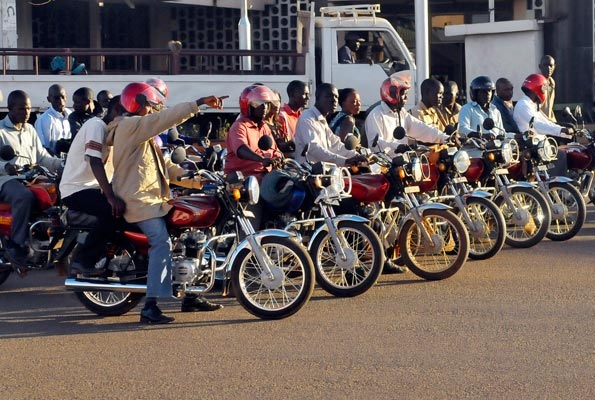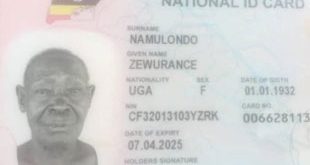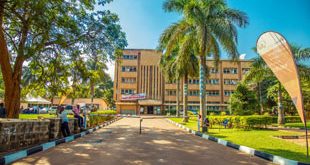
Kampala, Uganda | THE INDEPENDENT | Sixteen-year-old Ruth Nalubega has lost interest in learning after losing both arms in a boda boda accident. It all started on July 24, 2021, when the teenager picked a boda boda in Mukono town at around 5pm to rush her to Lugazi town, about 18km away.
Since Uganda was in the second nationwide COVID-19 induced lockdown, the government had suspended both public and private transport. Only vehicles moving essential workers accredited by the Ministry of Works and Transport and cargo trucks had permission to move.
When President Yoweri Museveni announced the second lockdown, Nalubega had visited her uncle in Mukono municipality. However, as weeks passed by, she developed the urge of returning to her parents in Kigenda, Lugazi town in Buikwe district. The only option was to use boda bodas that were operating illegally, which she did.
However, a speeding truck cut short her journey when it hit the motorcycle throwing her underneath its tyres. “I found myself under the tyres of the truck. I do not remember how people removed me from there and took me to the hospital. I regained my consciousness when I was at Mulago hospital and I didn’t have any of my arms,” Nalubega narrates.
Nalubega is just one of the many victims of road accidents along the Kampala-Jinja highway, which falls under the Kampala Metropolitan Police East region. The highway registers more than 1,400 crashes involving motorcycles and vehicles every year according to police statistics.
Most of the victims of road crashes along the Jinja-Kampala highway end up at Kawolo hospital for treatment or first aid before they are referred to better facilities. Dr. Haruna Wamala, the administrator of Kawolo hospital says that they registered 31 victims of motorcycle crashes between July and September this year.
Ndugu Omongo, the Executive Director of Uganda Professional Drivers Network-UPDN, argues that lack of training for boda-boda riders is one of the major reasons behind the crashes. Omongo believes if there were training centers for riders like it is for drivers, it could help to instil skills and discipline into motorcyclists.
“The boda-boda job is seen as a survival venture for many youths. They buy motorcycles or ride for their bosses without any skills. Many do not know what road signs mean. Training schools teach someone how to be patient and how to respect other road users. Many boda-boda riders are impatient and they get knocked for that,” Omongo said.
URN spoke to 21 boda-boda riders about Omongo’s assertions. Sixteen motorcyclists found on Entebbe, Jinja and Masaka roads and some in Bunyoro region admitted that they never had any formal training before venturing into the boda-boda business.
For instance, Francis Abigaba whose treatment for a head injury he sustained in a boda boda accident, according to hospital documents seen by URN, cost more than Shillings 9million and Desmond Birungi, who is nursing wounds, both said they learnt on the job.
Birungi and Abigaba are residents of Kibaale district which falls under the Albertine region where 200 people die in accidents every year according to police figures. The duo also attributes accidents to small roads, where they compete with trucks carrying agricultural produce.
Dr Olive Kobusingye, a renowned injury epidemiologist and former head of the Trauma Unit at Mulago National Referral Hospital, does not subscribe to the argument that setting up training centers would minimize boda-boda crashes. She agitates for the total ban of boda-boda transport in crowded areas like Kampala through the introduction of mass carrier buses.
Several attempts have been made to streamline boda-boda transport, which is estimated to be employing between 150,000 and 300,000 people in Kampala alone. The Boda-boda 2010 Association started with the hope of organizing the sector. However, the organization ended up being owned by a gang of ‘untouchables’ who tormented their fellow riders and extorted money from them leading to the arrest of its leaders and eventual collapse.
Digital associations of boda-boda riders was another venture the government and private sector players thought would organize the riders. The clients could access services by simply making a request using an application on the mobile phone. However, the majority of these associations are crumbling and thousands of their members have since quit claiming they are being exploited.
In 2012, the government through the Ministry for Works and Transport unveiled a master plan catering for specialized ways for pedestrians, cyclists and motorcyclists as well as mass carriers to minimize congestion and chaos on roads. However, almost 10 years later, the interventions have remained on paper.
Dr Kobusingye explains that without prioritizing mass carriers like buses for people who regularly come to work in Kampala, Ugandans will continue paying highly for the risky boda-boda transport because it is seen as a faster alternative. In addition, Kobusingye says millions of Shillings are spent on treating boda-boda accident victims while some people have sustained permanent conditions and need care for the rest of their life.
Abigaba and Agnes Nakanani’s experiences amplify D. Kobusingye’s explanation of the medical costs for boda boda accident victims. Abigaba says if it were not for his elder brother, a catholic priest, friends and fellow boda-boda riders who raised more than Shillings 9 million for his treatment, he would perhaps have died.
Nakanani, who is also the mother of Nalubega, says that she has borrowed from almost every person she knows to treat her daughter. Nakanani applauds area politicians and friends who came to her rescue because the hospital bills had been extremely huge for her and her husband.
Dr Kobusingye, says more than 40 percent of the financial budget allocated to the Mulago trauma centre is spent on treating victims of boda-boda crashes. Dr. Wamala says that at Kawolo hospital, the treatment of accident victims is ten times more compared to inpatients.
The police report for 2020 released by Commissioner Lawrence Niwabiine shows that more than 1,500 die in boda-boda accidents every year while over 4,000 survive with heinous injuries. This article is done with support from International Centre for Journalists (ICFJ) and World Health Organisation (WHO) purposely for road safety.
*****
URN
 The Independent Uganda: You get the Truth we Pay the Price
The Independent Uganda: You get the Truth we Pay the Price


